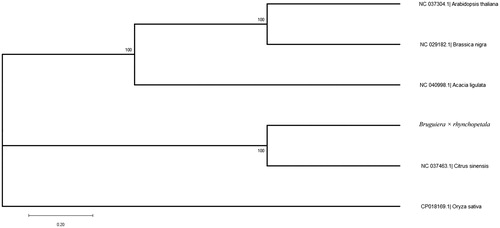Abstract
The complete mitochondrial genome of mangrove plant: Bruguiera sexangula (Lour.) Poir. var. rhynchopetala Ko was analyzed in this paper, which is the first for the genus within the family Rhizophoraceae. The mitogenome sequence is 286,503 bp in length containing three ribosomal RNA genes, 25 transfer RNA genes, and 35 protein-coding genes. Genes ccmFc, rps3 and cox2 contain one intron, gene nad5 contains two introns, genes nad1 and nad4 contain three introns, and genes nad2 and nad7 contain four introns. Genes nad1, nad2 and nad5 are trans-splicing genes. Phylogenetic analysis using the maximum-likelihood method positioned Bruguiera × rhynchopetala closely with Citrus sinensis in Rosales.
Bruguiera sexangula (Lour.) Poir. var. rhynchopetala Ko belonging to Rhizophoraceae species is widely distributed from India, Malay, Sri Lanka, Thailand, and Vietnam to South China (Wang and Wang Citation2006), and usually located with B. sexangula and B. gymnorrhiza (Tomlinson Citation2006). Bruguiera sexangula (Lour.) Poir. var. rhynchopetala Ko is the natural hybrid of B. sexangula and B. gymnorrhiza and is the only hybrid reported for this genus (Duck Citation2006). Mitochondrial genome-based phylogenetic analysis would improve our understanding of the evolutionary relationship of this plant under tidal habitat. In this study, we sequenced and analyzed the complete mitochondrial DNA sequence of B. sexangula (Lour.) Poir. var. rhynchopetala Ko. This is the first complete mitogenome within the family Rhizophoraceae or even in Malpighiales.
Fresh leaves were collected from three individuals of B. sexangula (Lour.) Poir. var. rhynchopetala Ko in Dongzhai Harbor Mangrove Natural Garden, Hainan Island (N19°51′–20°01′, E110°32′–110°37′), China. The total genomic DNA was extracted from 10 mixed fresh leaves of B. sexangula (Lour.) Poir. var. rhynchopetala Ko by using the modified CTAB method (Doyle Citation1987) in the laboratory of Hainan Normal University. Further, the specimen was also stored in the herbarium of Hainan Normal University (No. Sp20190801-004). Genome sequencing was performed on an Illumina Hiseq X Ten platform with paired-end reads of 150 bp. In total, 64.7 Gb short sequence data obtained with Q20 was 94.64%. The remaining high-quality reads were used to assemble the mitogenome using NOVOPlasty (Dierckxsens et al. Citation2016), where Arabidopsis thaliana (GenBank accession NC_037304.1) was used as the seed sequence. The genes annotation in the mitogenome was done with SPAdes v.3.9.0 (Bankevich et al. Citation2012) and some genes were annotated manually. The accession number in Genbank is MT130511. Six mitogenome sequences in Rosales were aligned including B. sexangula (Lour.) Poir. var. rhynchopetala Ko, Oryza sativa was used as the outgroup species. Phylogenetic analysis using the maximum-likelihood algorithm was conducted with Mega X (Kumar et al. Citation2018).
The mitogenome of B. sexangula (Lour.) Poir. var. rhynchopetala Ko is 286,503 bp in length with GC content of 44.29%, which contains three ribosomal RNA genes (rrn5, rrn18 and rrn26), 25 transfer RNA genes, and 35 protein-coding genes. Among those genes, ccmFc, rps3 and cox2 contain one intron, gene nad5 contains two introns, genes nad1 and nad4 contain three introns, and genes nad2 and nad7 contain four introns. Genes nad1, nad2 and nad5 are trans-splicing genes. Phylogenetic analysis with other four plant mitogenomes showed that B. sexangula (Lour.) Poir. var. rhynchopetala Ko is closest with Citrus sinensis in Rosales (). The useful genomic resources for the characterization of genetic diversity of B. sexangula (Lour.) Poir. var. rhynchopetala Ko by the mitogenome will help for the study of evolution mechanism and the protection of germplasm resources.
Disclosure statement
No potential conflict of interest was reported by the author(s).
Additional information
Funding
References
- Bankevich A, Nurk S, Antipov D, Gurevich AA, Dvorkin M, Kulikov AS, Lesin VM, Nikolenko SI, Pham S, Prjibelski AD, et al. 2012. SPAdes: a new genome assembly algorithm and its applications to single-cell sequencing. J Comput Biol. 19(5):455–477.
- Dierckxsens N, Mardulyn P, Smits G. 2016. NOVOPlasty: de novo assembly of organelle genomes from whole genome data. Nucleic Acids Res. 45(4):e18.
- Doyle J. 1987. A rapid DNA isolation procedure for small quantities of fresh leaf tissue. Phytochem Bull. 19:11–15.
- Duck NC. 2006. Australia’s mangroves. Brisbane: University of Queensland Press.
- Kumar S, Stecher G, Li M, Knyaz C, Tamura K. 2018. MEGA X: molecular evolutionary genetics analysis across computing platforms. Mol Biol E. 35(6):1547–1549.
- Tomlinson PB. 2006. The botany of mangrove. Cambridge: Cambridge University Press.
- Wang WQ, Wang M. 2006. The mangroves of China. Beijing: Beijing Science Press.

